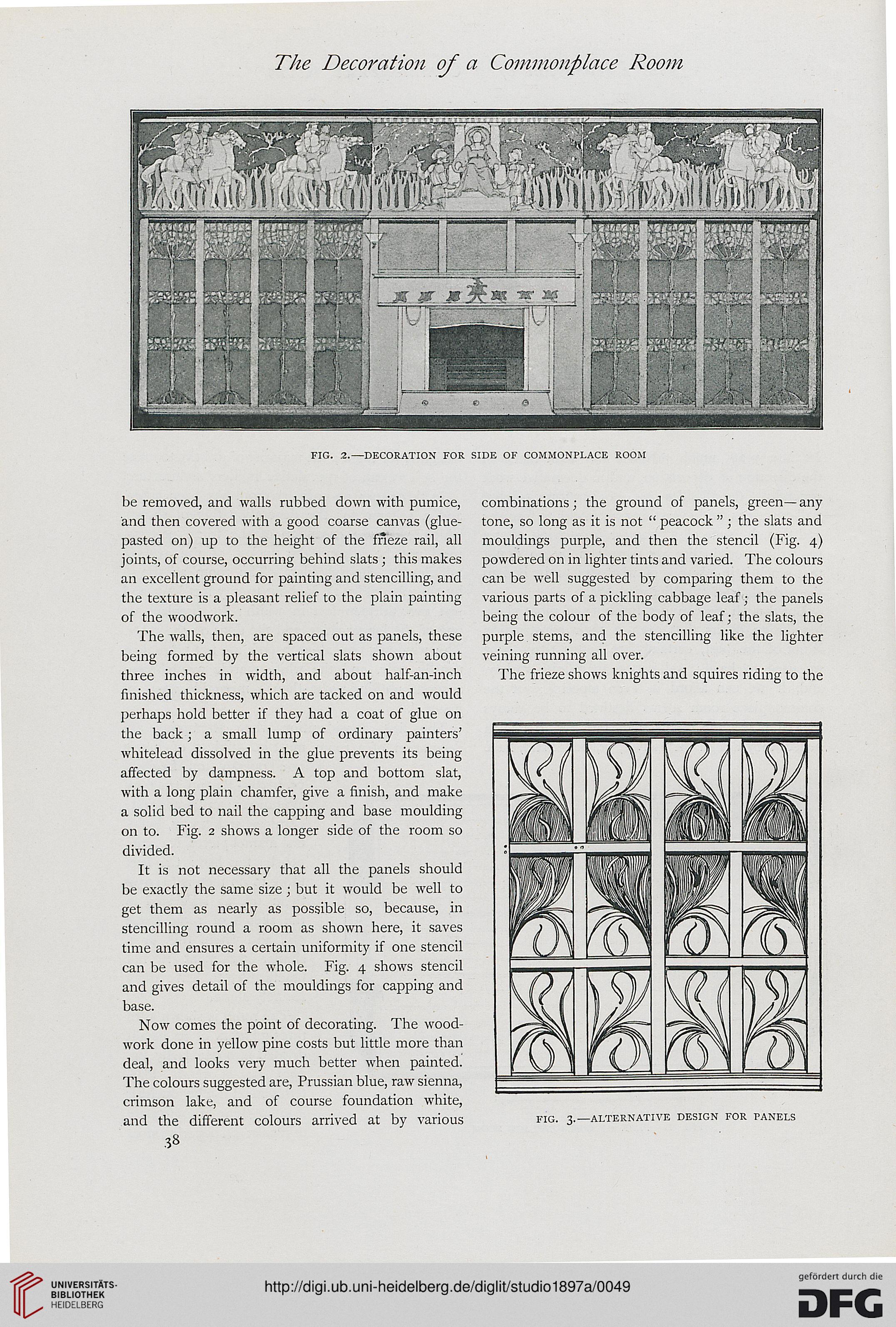The Decoration of a Commonplace Room
FIG. 2.—DECORATION FOR SIDE OF COMMONPLACE ROOM
be removed, and walls rubbed down with pumice,
and then covered with a good coarse canvas (glue-
pasted on) up to the height of the frieze rail, all
joints, of course, occurring behind slats; this makes
an excellent ground for painting and stencilling, and
the texture is a pleasant relief to the plain painting
of the woodwork.
The walls, then, are spaced out as panels, these
being formed by the vertical slats shown about
three inches in width, and about half-an-inch
finished thickness, which are tacked on and would
perhaps hold better if they had a coat of glue on
the back; a small lump of ordinary painters'
whitelead dissolved in the glue prevents its being
affected by dampness. A top and bottom slat,
with a long plain chamfer, give a finish, and make
a solid bed to nail the capping and base moulding
on to. Fig. 2 shows a longer side of the room so
divided.
It is not necessary that all the panels should
be exactly the same size ; but it would be well to
get them as nearly as possible so, because, in
stencilling round a room as shown here, it saves
time and ensures a certain uniformity if one stencil
can be used for the whole. Fig. 4 shows stencil
and gives detail of the mouldings for capping and
base.
Now comes the point of decorating. The wood-
work done in yellow pine costs but little more than
deal, and looks very much better when painted.
The colours suggested are, Prussian blue, raw sienna,
crimson lake, and of course foundation white,
and the different colours arrived at by various
38
combinations; the ground of panels, green— any
tone, so long as it is not " peacock " ; the slats and
mouldings purple, and then the stencil (Fig. 4)
powdered on in lighter tints and varied. The colours
can be well suggested by comparing them to the
various parts of a pickling cabbage leaf; the panels
being the colour of the body of leaf; the slats, the
purple stems, and the stencilling like the lighter
veining running all over.
The frieze shows knights and squires riding to the
m
m
H
W
1 jJ?
1
FIG. 3.—ALTERNATIVE DESIGN FOR PANELS
FIG. 2.—DECORATION FOR SIDE OF COMMONPLACE ROOM
be removed, and walls rubbed down with pumice,
and then covered with a good coarse canvas (glue-
pasted on) up to the height of the frieze rail, all
joints, of course, occurring behind slats; this makes
an excellent ground for painting and stencilling, and
the texture is a pleasant relief to the plain painting
of the woodwork.
The walls, then, are spaced out as panels, these
being formed by the vertical slats shown about
three inches in width, and about half-an-inch
finished thickness, which are tacked on and would
perhaps hold better if they had a coat of glue on
the back; a small lump of ordinary painters'
whitelead dissolved in the glue prevents its being
affected by dampness. A top and bottom slat,
with a long plain chamfer, give a finish, and make
a solid bed to nail the capping and base moulding
on to. Fig. 2 shows a longer side of the room so
divided.
It is not necessary that all the panels should
be exactly the same size ; but it would be well to
get them as nearly as possible so, because, in
stencilling round a room as shown here, it saves
time and ensures a certain uniformity if one stencil
can be used for the whole. Fig. 4 shows stencil
and gives detail of the mouldings for capping and
base.
Now comes the point of decorating. The wood-
work done in yellow pine costs but little more than
deal, and looks very much better when painted.
The colours suggested are, Prussian blue, raw sienna,
crimson lake, and of course foundation white,
and the different colours arrived at by various
38
combinations; the ground of panels, green— any
tone, so long as it is not " peacock " ; the slats and
mouldings purple, and then the stencil (Fig. 4)
powdered on in lighter tints and varied. The colours
can be well suggested by comparing them to the
various parts of a pickling cabbage leaf; the panels
being the colour of the body of leaf; the slats, the
purple stems, and the stencilling like the lighter
veining running all over.
The frieze shows knights and squires riding to the
m
m
H
W
1 jJ?
1
FIG. 3.—ALTERNATIVE DESIGN FOR PANELS




